

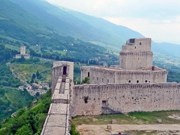
Rocca Maggiore (ca. 1362-5)

The first castle of the site seems to have been built by Charlemagne after he sacked the city in 773. However, the earliest surviving documentary reference to a fortress here dates to 1174, when Christian of Mainz subdued Assisi on behalf of the Emperor Frederick I. In the period 1177-98, this fortress was the main residence Conrad of Urslingen, whom Frederick I appointed as Duke of Spoleto and Count of Assisi. The citizens of Assisi tore it down when they declared a free commune in 1198. The site was probably fortified again in the early 14th century, but any such fortifications would have been destroyed in 1321 when Perugia finally subjugated the city.
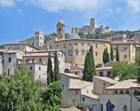
The fortress at the heart of the new defences, which was known as Rocca Maggiore, was central to the control of the city below. It formed part of the medieval walls of the city, between Porta San Giacomo and Porta Perlici. The additions made to it during the subsequent period are described below. The last of these was the circular bastion, which Pope Paul III built in 1535 to underline his control of the city. However, the fortress was no longer strategically important by this time, and fact underlined when he transferred its cannons to the Rocca Paolina, Perugia in 1543. Rocca Maggiore was then used as a prison until ca. 1600, when it was abandoned.
The Commune acquired the building in 1883 and restored it as a tourist attraction in ca. 1891-1900. It was extensively restored in 2002.
Tour of Rocca Maggiore
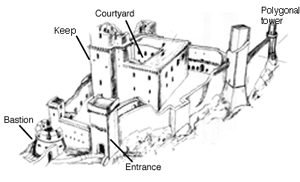
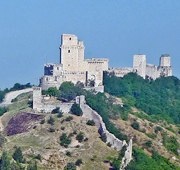
The oldest part of the castle is the central core, which is made up of the keep and associated buildings arranged around the central courtyard. This is surrounded by an outer barbican that encloses an open area to the north and east. As described below:
-
✴the polygonal tower to the north west was built in 1458-60; and
-
✴the circular bastion was added in 1535-8.
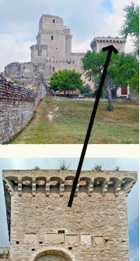
-
✴Pope Urban V;
-
✴the Church;
-
✴Cardinal Anglic de Grimoard, the younger brother of Urban V, was papal vicar in temporalibus in Italy from March 1368 until July 1371;
-
✴Cardinal Albornoz; and
-
✴the Boncompagni family of Assisi [who presumably provided the first castellan ?].
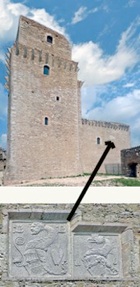
-
✴the arms of Bargiano d’ Andrea, the castellan at that time: and
-
✴the griffin of Perugia.
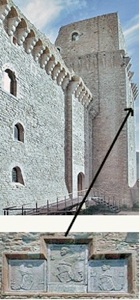
-
✴Biordo Michelotti;
-
✴Bargiano d’ Andrea; and
-
✴Nicolò di Giovanni Andreuzio, the Capitano del Popolo [of Assisi or Perugia ?].
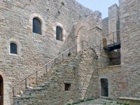


-
✴the sculpted arms of Pope Sixtus IV; and
-
✴the altar table from the altar that was inscribed with the name of his relation, the castellan Urbano Vegerio di Savona and the date 1482.
The room to the right as you leave the kitchen, which was also originally divided horizontally, was similarly used for residential purposes.
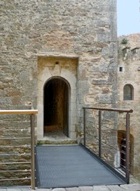
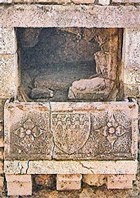
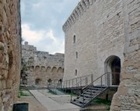
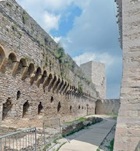
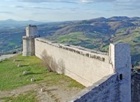
-
✴the lower passage, inside the connecting walls; and
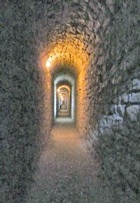
-
✴the upper passage, which no longer allows access to the tower, but allows the visitor to appreciate its strategic importance as a defended look-out tower.
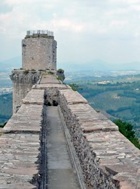
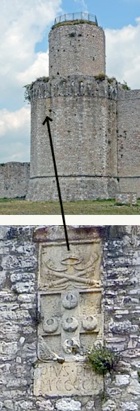
-
✴Giacomo Piccinino began this tower at the junction with the wall that leads towards Porta San Giacomo in 1458.
-
✴The inscription commemorates Pope Pius II, who completed the tower and built the corridor that links it to the main fortifications in 1460.
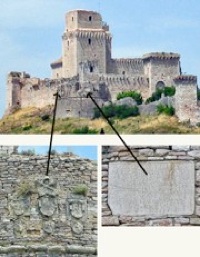
Rocca Minore (1365)
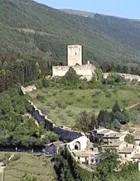
Rocca Minore also seems to have existed by 1174, and to have fallen into ruin by the early 14th century. Cardinal Gil Albornoz built this castle and the walls that connect it to Rocca Maggiore (via Porta Perlici, illustrated above) and to Porta Sant’ Antonio (to the right).
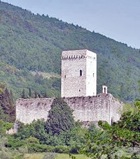
[The fresco (15th century) on the altar wall, which depicts the Crucifixion with the Virgin ad St John the Evangelist, is attributed to Matteo da Gualdo]
The Rocca Minore is still in restoration (at July 2009) after the earthquake of 1997.
Read more:
E. Sciamanna, “Rocca Maggiore”, (2008) Assisi, a booklet in Italian and English that is available at the ticket office.
There is a more detailed account of the history of the Rocca by Daniele Amone in the website Castelli dell' Umbria.
Return to Monuments of Assisi.
Return to Walk I.
Return to the home page on Assisi.

